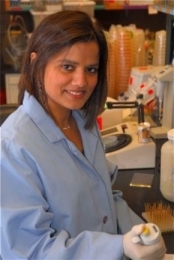
Name
Carol D'lima, PhD
Title
Post Doctoral Researcher
Institution
University of California, Davis
Education
2007: PhD, North Carolina State University, Food Microbiology
2004: MS, Purdue University, Food Microbiology
2002: BS, Purdue University, Microbiology and Food Science
What brought you to the University of California, Davis?
After my PhD I started looking for postdoc positions in various places and was interested in the type of research Dr. Trevor Suslow was doing in the field of food safety. I came to Davis, met with him, and liked the project I would be given if I chose to move out here. I also have family in the area, which is nice.
How did you learn about the Center for Produce Safety? What led you to apply for funding?
I originally heard about the center through a presentation given by Executive Director Bonnie Fernandez-Fenaroli. My curiosity led me to look up more about the center online. When the RFP was released, it stressed the importance of research aimed directly at helping farmers and the industry immediately. I liked the aspect which emphasized “impact” because I wanted to show a direct effect on the food industry. I think this is a very important aspect that more funding should concentrate on. All projects are important but ideally I want to see an immediate impact.
CPS awarded funding to your project “Enhancing the effectiveness of Human pathogen testing systems for the advancement of practical produce safety research and commercial management." What are the key factors influencing this field of inquiry?Right now there is no universal method for detecting pathogenic E. coli in produce. Testing has become more frequent since the 2006 E. coli outbreak in spinach, and there are many commercial products available. However most of these methods were developed for meat and are only recently being certified for produce. As a result, many issues have not been adequately studied and this leads to significant problems with test kits. For example, rapid test kits are affected by the commodity being tested and this needs to be looked into. In addition, most methods for pathogenic E. coli target O157:H7, and with the increase in outbreaks related to other pathogenic E. coli tests are needed to cater to broader needs of environmental, wildlife, and product-based testing. My research is aimed at developing a system that researchers, regulators and industry can use for the rapid detection of a broad group of pathogenic and toxigenic E. coli in produce and produce environments.
What do you think the industry will gain from your research?
I am hoping to validate the universal screening method on a wide variety of samples and apply it to better understand the presence of pathogenic E.coli strains other than O157 as a food safety risk. The industry will gain an option in rapid-testing technologies targeted to include a broader set of pathogenic E. coli which is receiving increasing scrutiny and concern by the public health system.
Where do you see the field of food safety research five years down the road? Why?
I recently attended a symposium sponsored by CPS where the companies shared information regarding their testing systems as well as some of the results they had been getting with the testing systems they are currently using. I am hoping more companies begin to take these steps over the next few years and realize the importance of collaboration between the industry and researchers. Such collaboration might help bring about more effective ways of improving detection for diverse environments and will help researchers to solve problems that the industry is dealing with. I see more of a “help us, help you” relationship developing.
Aside from working in the laboratory, how else do you spend your time?
I spend most of my time at work, writing reports, helping with grant writing as well as training others on how to use the systems in the lab. For fun, though, I am a member of the 4-H in Sacramento, and take kids for science camps. I also enjoy outdoor adventures such as white water rafting, sea kayaking and most importantly spending time with my family.
Lastly, what would you consider a career highlight?
The major highlight of my career was making a transition from my graduate work on Campylobacter in turkeys to food safety issues for fresh produce. This is work I really enjoy and feel is a crucial part of food safety. Getting the CPS grant was especially satisfying for me since I played a major role in writing the proposal. I was thrilled to be one of the first researchers to get an award.